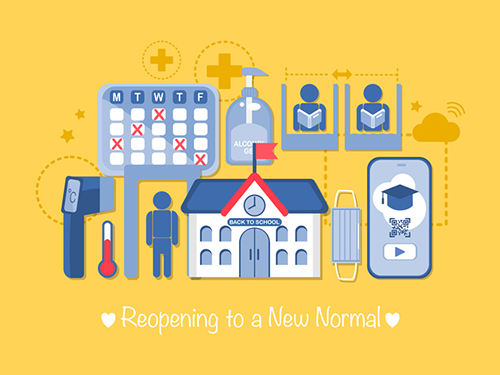Reopening schools during the COVID-19 pandemic has brought uncertainty and stress for many parents and children. While you are trying to understand what you and your family will do, many children and teens have anxiety about what to expect during the school year. And it’s important to help manage the stress.
Whether your child will be learning in-person, online or with a mix of both, here are some tips to help manage back-to-school stressors.
Talk about it and plan together
To help manage the stress, talk with your children about the possible changes to their classroom. If your child is returning to in-person class, address the new guidelines set up for their rooms. It’s important to prepare them for what they were experience, such as their desks being further away from others, washing hands more frequently and wearing masks all day.
If your child is starting back to virtual classes, explain why this is happening and how they will still engage with their teachers and classmates. Be open and honest with your child in a way they will understand that these measures are in place to help them and their classmates stay healthy.
Acknowledge their feelings
Let your child know it is normal to feel scared or anxious about the new school year. Validate their thoughts and emotions. You don’t have to fix the problem, instead, help them think about what they can do to help manage the stress and create a positive school environment. Dispel any rumors or myths they may have and give them the correct, age-appropriate information. Share how this is a challenging time and you may not have all the answers but will always be there to listen.
Set goals
Work with your child to set goals for the school year as they adjust to a new way of learning. Work together to find ways for your child to learn inside and outside of the classroom even though their school environment may look different. It may start with setting up a schedule each week, creating a list of what extracurricular activities you can do at home or learning to navigate the online school platform.
Stay Connected
It is important for children to stay connected with their peers and family members during this time. Encourage socialization and connectivity by finding creative ways for your child to engage with others. This may look like virtual art and STEM projects or socially distanced play in the backyard. You can also encourage writing letters to relatives they have not been able to see. Make time to do more together as a family and check in, whether it is weekly game nights or evening walks after dinner. This will give everyone time to share how they are feeling, what’s happening throughout the school week.
Look out for behavior change
Be aware of any behavior or emotional changes with your child. It is normal for children to have bad days or an outburst but watch for any possible patterns in their behavior. Is your child having trouble sleeping, becoming disengaged or not enjoying what they once liked doing? You know your child best and can detect if there is something wrong. If there is an increase in concerning behavior, talk with your child about how they are feeling to help them manage the stress. It may also be a good time to consult with a school psychologist or another licensed mental health professional for additional help.
Additional back-to-school resources
- Books to Help Kids Cope with COVID-19
- 8 ways teachers can continue supporting students during the COVID-19 era
- 9 Tips for Motivating Children to Learn at Home
This resource is made possible through a partnership between the American Psychological Association and National PTA to educate parents and teachers about behavioral health and emotional well-being.





